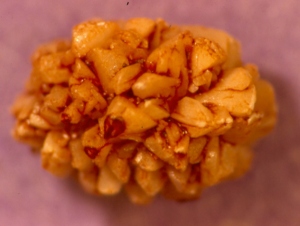Crystalluria

Crystalluria
Crystalluria is the next frustrating urinary condition in the FLUTD complex that our kitties have to endure, and it is another very common medical condition and reason for a visit to the veterinarian.
What is it and why do they form?
The condition is caused by actual microscopic crystals forming in the urine. These crystals form when minerals are super-saturated in the urine and then precipitate out into crystals. The predisposing factors behind their development are not fully understood and are thought to be related to urine pH fluctuations, genetics, bacteria and possibly viruses, stress, diet, and food supplementations (sounding familiar?!).
While there are many crystals that can form, two of the most common types found in cats are calcium oxalate and struvite crystals. Calcium oxalate crystals can form in any pH, while struvite crystals tend to form most commonly in the higher pH ranges of seven and greater.
What are the clinical signs of crystalluria?
The signs of crystalluria are the same as that of any FLUTD… straining to urinate, licking of the genital regions, vocalizing, blood-tinged urine, frequent trips in and out of the litter box, and just plain unhappiness. These signs are seen because crystalluria can hurt like crazy… just imagine having little shards of glass floating around in your bladder, irritating its lining, and going through your urethra every time you urinate. Ouch!
This is also why a lot of cats will start urinating outside of their litter box; they begin to associate the litter box with pain, and tend to seek other areas to urinate that will cause them less discomfort (your bed, the laundry basket, the couch…).
How is crystalluria diagnosed?
Proper identification of urine crystals is important for determining the medical strategy needed for treating the condition. Analyzing a sterile urine sample under a microscope is the major diagnostic tool used to identify crystals. A sterile urine sample is collected by a process called cystocentesis, which is inserting a sterile needle through your kitty’s belly and into the bladder to collect the urine. I know this sounds a bit barbaric, but I can honestly say 99% of the cats I perform urine collection on do not feel the needle.
Specific tests are conducted on the urine to examine the pH, protein contents, blood contamination and the crystal contents of the urine sediment (concentrated urine). The urine is also looked at under the microscope and this is how the type of crystals can be visually diagnosed.
There are several different types of crystals that form in urine; the most common one in cats is magnesium ammonium phosphate (or ‘struvite’) and calcium oxalate. Any breed of cat can be prone to struvite crystals and specific breeds that are prone to calcium oxalate crystals are Burmese, Himalayan, and Persian cats.
The following is a picture of struvite crystals as they appear under the microscope:
What is the treatment for crystals?
Treatment will involve eliminating or controlling the underlying cause(s) and associated risk factors. Minimizing crystalluria can be achieved by:
• Increasing urine volume by increasing water intake to help “keep the bladder flushed”: this can be accomplished by changing from a dry diet formula to a wet one, as well as bringing in additional water sources into the home such as kitty fountains (and its good feng shui!)
• Encouraging complete and frequent voiding of urine by placing litter boxes in a quiet and non distracting environment
• Modifying pH levels of the urine through a prescription diet: the recommended diet then has to be fed as the cat’s sole diet and can take 2 months to fully dissolve the crystals; once they are dissolved, to prevent the crystals from forming again, cats generally have to be maintained on this prescription diet for life and have regular 6-12 monthly urine tests to monitor their progress; for those of you with multiple cat households, your veterinarian may recommend a “whole household” diet change
• In some instances appropriate drug therapy may be part of the treatment plan
What complications can having crystalluria lead to?
Chronic crystalluria may progress to the development of crystalline-matrix plugs, which can result in life-threatening urethral obstruction. This is basically a “snow ball” effect, and all of the crystals, mucus, and inflammatory cells in the bladder conglomerate into a plug and lodge in the urethra, making the cat unable to urinate. This is one of the biggest complications that I see and treat, and is one of the major reasons I feel crystals in the urine have to be aggressively addressed.
Because crystals irritate the bladder wall, infections can also become a problem, and urine cultures may be recommended to confirm an infection.
If crystals are left untreated, stone formation known as urolithiasis, can occur. If bladder or kidney stones do occur, surgery is generally required for their removal as it is very rare that diets can dissolve stones. The detection of urinary crystals is not synonymous with kidney stones, or a stone-forming tendency, but there is some association with an increased risk of their development. A radiograph or ultrasound is needed to diagnose stones.
The following is a picture of struvite crystals that have formed into an actual stone that was surgically removed from the bladder:
Next weeks class will tackle the issue of urethral obstruction- the scariest complication of FLUTD. It is another common occurrence and just this past weekend we had three kitties hospitalized for this!







At this time I am going away to do my breakfast,
after having my breakfast coming yet again to read additional news.